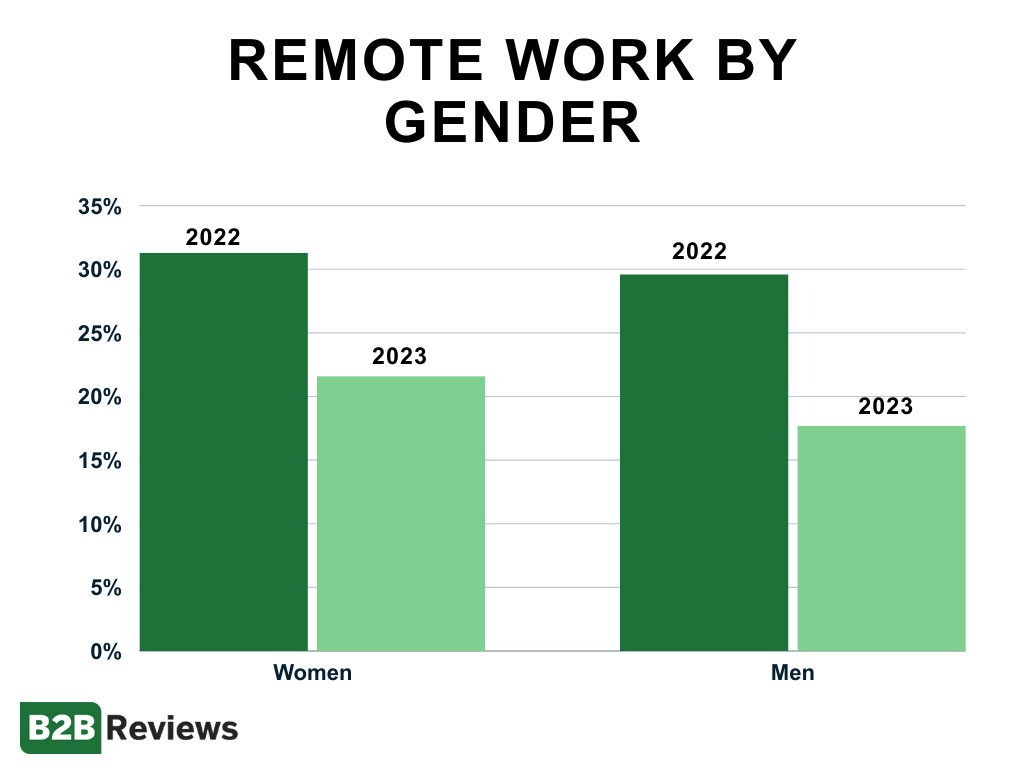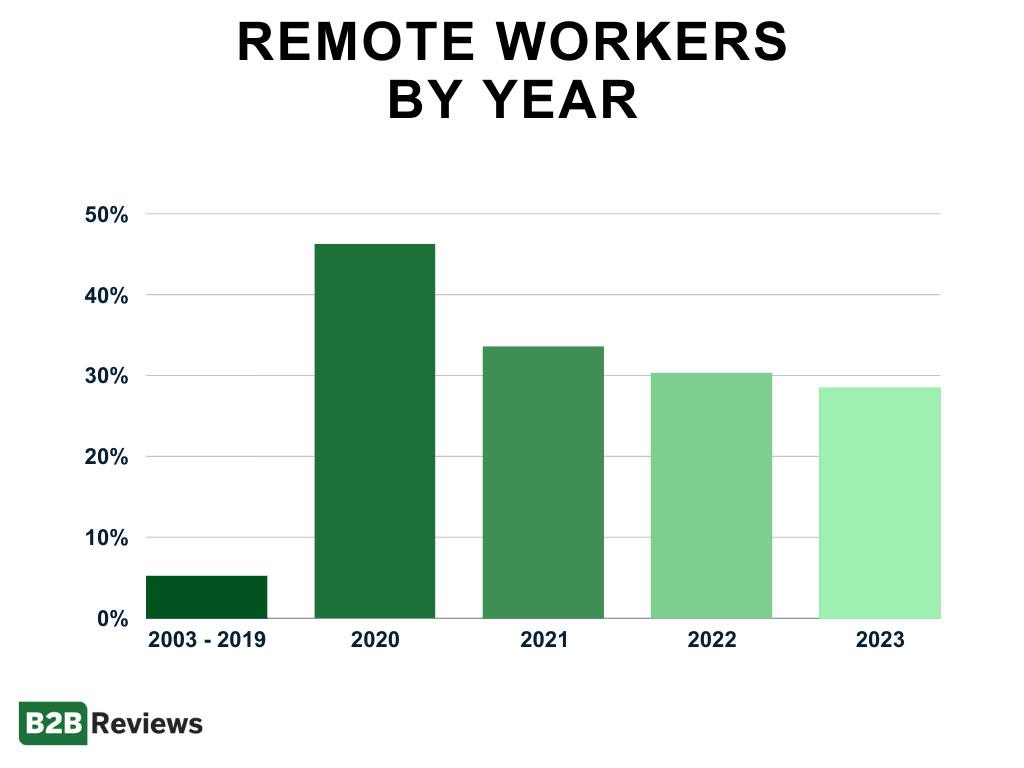Since the pandemic, remote work has become increasingly popular. More and more people are working from their homes, cafes, and other off-site locations. The COVID-19 pandemic showed that remote work is not only possible for many occupations, but it is beneficial.
With flexible work schedules and reduced commute times, remote employees have found they have increased mental health and a better work-life balance. However, with the pandemic behind us, employers are eagerly calling workers back to the office.
So, how many people actually work remotely? We gathered the most recent statistics to find out how common remote work actually is in 2024.
Key Takeaways
- As of August 2023, 12.2% of U.S. workers are fully remote.
- More than 4.7 million U.S. workers are remote at least half of the time.
- Only 11.1% of private sector businesses are fully remote.
- 65% of workers want to be remote all the time, while 32% prefer a hybrid work schedule.
- About 32.6 million Americans are estimated to be working remotely by 2025.
Remote Work Statistics
There are many different insights into remote work. Various studies have found that while fully remote work isn’t as common as one might think, hybrid work (working from a home office some days and in person other days) is more prevalent.
- An average of 12.2% of workers are fully remote in 2023, as of August.
- In 2022, an average of 14.3% of workers were fully remote.
- Only 11.1% of private sector establishments are fully remote.
As you can see the percentage of fully-remote workers is declining steadily. However, a study by Upwork found that 65% of workers want to be remote all the time, and only 32% said they preferred the hybrid schedule.”
Overall, remote work is gradually becoming less common, despite the majority of workers citing the benefits of remote work (such as workplace flexibility) and increased productivity.
- 66% of millennials feel most productive working from home.
- 46% feel more productive at home.
- 67% of hybrid workers feel they are more productive on the days they’re at home.
Additionally, a survey conducted by Slack asked 9,000 workers across six countries about their preferred work model and found that 72% of people prefer a hybrid model, and 13% want to always work from home. It’s no surprise, then, that more than 4.7 million U.S. workers are remote at least half of the time.
Recruiters feel different, despite signs of increased employee productivity, and are trying to increase the number of in-office employees. The large majority of employers (64%) either agree or strongly agree that they need people on-site to achieve their strategic goals. As such, 42% of companies across all industries require their employees to be on-site four or five days a week, lowering the percentage of fully remote workers considerably.
Remote Work Demographics
According to the U.S. Bureau of Labor Statistics, working remotely (teleworking) is more common among some demographics. Additionally, certain industries have higher percentages of remote workers than others.
Women are more likely to have worked remotely in recent years when compared to men.
- In 2022, 31.3% of women worked remotely.
- As of August 2023, 21.6% have worked remotely.
Men are less likely to have worked remotely in recent years when compared to women.
- In 2022, an average of 29.6% of men worked remotely.
- As of August 2023, only 17.7% of men were remote.
The percentage of people working remotely differs by race as well.
- 31.2% of Asians worked remotely.
- 19.3% of Whites worked remotely.
- 15.4% of Blacks worked remotely.
- 9.9% of Hispanics worked remotely.
Age also affects the number of people working remotely. The younger the worker, the less likely they are to have worked remotely.
- 6.6% for ages 16 to 24.
- 21.8% for ages 25 to 54.
- 20.6% for ages 55 and over.
For workers 25 and up, remote work becomes more common with increased education:
- 2% less than a high school diploma.
- 7% high school graduates (no college).
- 15.3% for some college.
- 36.1% bachelor’s degree and higher.
Foreign-born workers were less likely to have worked remotely in August at just 16.5%. While about 20.2% of native-born workers worked remotely in August 2023.
More full-time workers are remote than part-time workers.
- 20.7% of remote workers were full-time in August.
- 13.1% of remote workers were part-time in August.
What kind of industries have more remote work opportunities?
Certain industries have a higher percentage of remote workers, with information establishments being the highest due to a highly digital work environment.
- 67.4% of information industries have remote workers.
- 49.0% of professional and business industries have remote workers.
- 46.0% of educational industries have remote workers.
- 39.0% of wholesale trade industries have remote workers.
These aren’t the only industries with remote workers, though. According to a study by Indeed, civil engineering has seen an increase in remote job postings. In May 2022, 16.9% of civil engineering jobs had remote work options, and this jumped up to 22.1% in May 2023.
Indeed also found that software development is the top industry for remote work, with 42.9% remote job postings as of May 2023.
Where is remote work most common in the U.S.?
Some regions in America have more remote workers than others. For instance, the Southern states have less than 3% of remote workers. Some parts of the Northeast Corridor, the Pacific Northwest, and Northern California have more than 30% of remote workers, however.
Remote work statistics outside the U.S.
Fewer people worked remotely in 2023 when we consider the global scale:
- 8% of full-time employees work entirely from home globally.
- 26% have a hybrid schedule.
Work From Home Research looked at 34 countries in April-May 2023. Based on reports from their respondents, they found that full-time employees only worked from home 0.9 days per week.
They also found that “work from home” levels are more common in English-speaking countries. Full-time employees worked remotely an average of 1.4 full-paid days per week in the U.S., Canada, the UK, New Zealand, and Australia.
The average “work from home” days are less in most other places:
- 0.7 days in seven Asian countries.
- 0.8 days in European countries.
- 0.9 days in four Latin American countries.
- 0.9 days in South Africa.
The study found many respondents report the typical office work model is most common outside of North America. Yet, many job seekers are becoming more interested in remote opportunities.
Trends and future predictions of the number of remote workers
Remote work skyrocketed with the coronavirus; however, it was not a new concept. It had been steadily growing in the years before, especially with the dawn of the internet. Few people, outside of the self-employed, programmers, and the like, thought of remote work as a viable option. Between 2003 and 2019, only an average of 5.2% of workers had remote work arrangements.
This percentage leaped to 46.3% in 2020, and people found that they could do their jobs just as well, if not better, at home. However, in the following years, this percentage has slowly declined.
We have seen a slow drop in how much of the U.S. workforce is remote (including hybrid) between the years 2021 and 2023:
- 33.6% in 2021
- 30.3% in 2022
- 28.5% in 2023
Despite the steady decline and more employers warning to return to the office, Upwork estimates that 32.6 million Americans will still be working remotely by 2025. This equates to about 22% of the workforce.
Remote work is also on the rise in Australia, Canada, New Zealand, the United Kingdom, and the United States, with more than 10% of job postings offering remote work. Interestingly, a Harvard study found that the U.S. has one of the highest rates of remote work after New Zealand and Canada.
The Bottom Line
Remote work has become more common ever since the pandemic, in one form or another. While hybrid is more common than fully remote, the idea of working away from the office appeals to more people than ever before. As of 2023, 12.2% of U.S. workers were fully remote, and about 28.5% of workers were remote at least some of the time.
Though remote work was not a new thing, the coronavirus brought it into the public consciousness. Many feel that remote work offers a better work-life balance and removes the stress of the daily commute. This is likely why 46% of workers feel more productive when they work from home on a typical workday.
The years following the pandemic have seen a decline in the number of people who telework, but the number is much greater than in pre-pandemic years and will only continue to grow. Upwork estimates that 32.6 million Americans will be working remotely by 2025. The number will likely grow as technology improves and brings even more remote work options. Remote work, whether hybrid or fully remote, may likely become the new normal for many U.S. employees.
Considering hiring remote employees and aren’t sure how to onboard them? Many companies use HR Software and project management tools to help onboard their workers and keep track of assignments. These tools ensure that your remote workers are just as effective as in-office employees while keeping your business running smoothly. Check out the tools above to see which one works for you.



